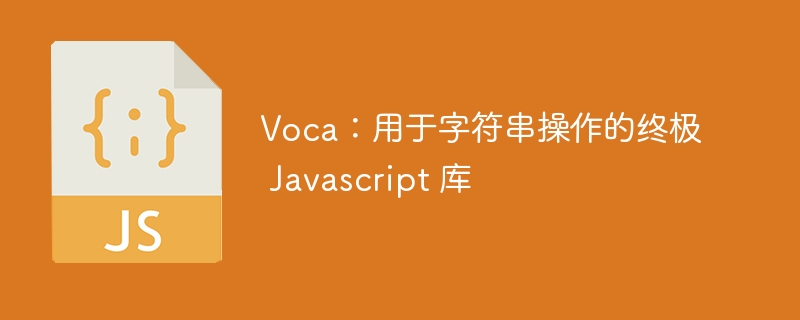Voca:用於字串操作的終極 Javascript 函式庫
- WBOYWBOYWBOYWBOYWBOYWBOYWBOYWBOYWBOYWBOYWBOYWBOYWB轉載
- 2023-08-30 17:45:121803瀏覽

Voca 是用於操作字串的 JavaScript 函式庫。在本教程中,我們將透過多個範例來展示如何使用 Voca 中提供的不同功能。
Voca 的功能
在查看所有範例之前,讓我們先重點介紹 Voca 帶來的一些功能 -
它提供了大量可用於操作、查詢、轉義、格式化字串的函數。
它還提供了詳細且可搜尋的文件。
它支援廣泛的環境,如 Node、js、Safari 7 、Chrome、Firefox 等。
它不需要任何依賴項
如何安裝 Voca?
現在我們已經了解了 Voca.js 的功能,讓我們看看如何將其安裝在我們的本機電腦上。若要安裝 Voca,請在終端機中執行以下命令 -
npm install voca
在終端機中執行上述命令後,將建立一個「package.json」檔案以及「package-lock.json」和一個「node_modules」資料夾。現在,我們準備在程式碼中使用 Voca 函數。
由於我們將討論 Voca 的許多功能,因此最好將它們分為不同的常見類別。
更改字串大小寫
我們將探討的第一類範例是案例,其中我們更改特定文字的大小寫。
camelCase() 函數
當我們想要將文字轉換為其駝峰式大小寫表示形式時,將使用 camelCase() 函數。考慮下面所示的程式碼。
const v = require('voca');
let companyName = 'tutorials point';
console.log("Input Text -", companyName);
console.log('Camel Case -', v.camelCase(companyName));
要執行上述程式碼,請先將其儲存為名稱“index.js”,然後執行以下命令。
node index.js
它將產生以下輸出
#Input Text - tutorials point Camel Case - tutorialsPoint
capitalize() 函數
當我們想要將文字轉換為其大寫表示形式時,將使用 capitalize() 函數。考慮下面所示的程式碼。
const v = require('voca');
let companyName = 'tutorials point';
console.log('Input Text –', companyName);
console.log('Capitalize –', v.capitalize(companyName));
它將產生以下輸出
#Input Text – tutorials point Capitalize – Tutorials point
decapitalize() 函數
當我們想要將文字轉換為其非大寫表示形式時,將使用 decapitalize() 函數。考慮下面所示的程式碼。
const v = require('voca');
let companyName = 'Tutorials point';
console.log('Input - ', companyName);
console.log('Decapitalize -', v.decapitalize(companyName));
它將產生以下輸出
#Input - Tutorials point Decapitalize - tutorials point
kebabCase() 函數
當我們想要將文字轉換為其 kebabCase 表示形式時,將使用 kebabCase() 函數。考慮下面所示的程式碼。
const v = require('voca');
let companyName = 'tutorials point';
console.log('Input -', companyName);
console.log('KebabCase -', v.kebabCase(companyName));
它將產生以下輸出
#Input - tutorials point KebabCase - tutorials-point
snakeCase() 函數
當我們想要將文字轉換為它的snakeCake 表示形式時,就會使用snakeCase() 函數。考慮下面所示的程式碼。
const v = require('voca');
let companyName = 'tutorials point';
console.log('Input -', companyName);
console.log('snakeCase -', v.snakeCase(companyName));
它將產生以下輸出
#Input - tutorials point snakeCase - tutorials_point
lowerCase() 函數
當我們想要將文字轉換為其小寫表示形式時,將使用 lowerCase() 函數。考慮下面所示的程式碼。
const v = require('voca');
let companyName = 'TUTORIALS point';
console.log('Input -', companyName);
console.log('LowerCase -', v.lowerCase(companyName));
它將產生以下輸出
#Input - TUTORIALS point LowerCase - tutorials point
swapCase() 函數
當我們想要將文字轉換為其 swapCase 表示形式時,將使用 swapCase() 函數。考慮下面所示的程式碼。
const v = require('voca');
let companyName = 'tutorials point';
console.log('Input -', companyName);
console.log('SwapCase -', v.swapCase(companyName));
它將產生以下輸出
#Input - tutorials point SwapCase - TUTORIALS POINT
titleCase() 函數
當我們想要將文字轉換為其 titleCase 表示形式時,將使用 titleCase() 函數。考慮下面所示的程式碼。
const v = require('voca');
let companyName = 'tutorials point';
console.log('Input -', companyName);
console.log('TitleCase -', v.titleCase(companyName));
它將產生以下輸出
#Input - tutorials point TitleCase - Tutorials Point
upperCase() 函數
當我們想要將文字轉換為其大寫表示形式時,將使用 upperCase() 函數。考慮下面所示的程式碼。
const v = require('voca');
let companyName = 'tutorials point';
console.log('Input -', companyName);
console.log('UpperCase -', v.upperCase(companyName));
它將產生以下輸出
#Input - tutorials point UpperCase - TUTORIALS POINT
使用 Voca 進行連結
連結是指我們能夠將多個函數一個接一個地連結起來。考慮下面所示的程式碼。
const v = require('voca');
let str = 'Tutorials Point is Awesome!';
console.log('Creating a chain object -', v(str).lowerCase().words());
console.log('Chaining and Wrapping -', v.chain(str).lowerCase().words().value());
它將產生以下輸出
#Creating a chain object - [ 'tutorials', 'point', 'is', 'awesome' ] Chaining and Wrapping - [ 'tutorials', 'point', 'is', 'awesome' ]
使用 Voca 進行斬波
Chopping 包含字串操作函數,如 charAt()、first()、last() 等。
charAt() 函數
當我們想要取得出現在特定索引處的字元時,使用charAt()函數。考慮下面所示的程式碼。
const v = require('voca');
let thingsILove = 'Formula1-Football-Leetcode-Sleeping';
console.log('Input String -', thingsILove);
console.log('charAt 10th index -', v.charAt(thingsILove, 10));
console.log('charAt 7th index -', v.charAt(thingsILove, 7));
它將產生以下輸出
#Input String - Formula1-Football-Leetcode-Sleeping charAt 10th index - o charAt 7th index - 1
first() 函數
當我們想要從文字中提取第一個字元時,使用first()函數。考慮下面所示的程式碼。
const v = require('voca');
let thingsILove = 'Formula1-Football-Leetcode-Sleeping';
console.log('Input -', thingsILove);
console.log('first -', v.first(thingsILove));
console.log('first -', v.first(thingsILove, 8));
它將產生以下輸出
#Input - Formula1-Football-Leetcode-Sleeping first - F first - Formula1
last() 函數
當我們想要從文字中提取最後一個字元時,使用last()函數。考慮下面所示的程式碼。
const v = require('voca');
let thingsILove = 'Formula1-Football-Leetcode-Sleeping';
console.log('Input -', thingsILove);
console.log('last -', v.last(thingsILove));
console.log('last -', v.last(thingsILove, 8));
它將產生以下輸出
#Input - Formula1-Football-Leetcode-Sleeping last - g last - Sleeping
使用 Voca 進行切片
當我們想要從文字中提取切片時,使用slice()函數。考慮下面所示的程式碼。
const v = require('voca');
console.log(v.slice('Delhi', 1));
console.log(v.slice('India', -4));
它將產生以下輸出
#elhi ndia
使用 Voca 提取子字串
當我們想要從文字中提取子字串時,使用substring()函數。最後一個元素也將被包括在內。考慮下面所示的程式碼。
const v = require('voca');
console.log(v.substring('Delhi', 3));
console.log(v.substring('India', 2, 4));
它將產生以下輸出
#hi di
Voca 中的计数函数
当我们想要计算文本中出现的单词数时,使用count()函数。考虑下面所示的代码。
const v = require('voca');
console.log(v.count('Delhi'));
它将产生以下输出
5
计算子字符串的数量
当我们想要计算文本中存在的子字符串数量时,将使用 countSubstrings() 函数。考虑下面所示的代码。
const v = require('voca');
console.log(v.countSubstrings('India is beautiful. India is huge!', 'India'));
它将产生以下输出
2
Voca 中的索引函数
在与索引相关的方法中,我们将使用 indexOf() 函数,该函数主要在我们想要查找特定字符串出现在文本中的特定索引时使用。考虑下面所示的示例。
console.log(v.indexOf('India', 'n'));
console.log(v.indexOf('India', 'p'));
console.log(v.indexOf('Leetcode', 'e'));
它将产生以下输出
1 -1 1
请注意,在第二种情况下,搜索的输入字符串中不存在字母“p”,因此它返回“-1”作为输出。
在 Voca 中插入函数
当我们想要在文本之间插入特定文本时,使用insert()函数。考虑下面所示的示例。
const v = require('voca');
console.log(v.insert('cde','o',1));
它将产生以下输出
code
它在给定字符串的“1”位置插入了字母“o”。
Vocac 中的重复函数
当我们想要多次重复特定文本时,可以使用repeat()函数。考虑下面所示的示例。
const v = require('voca');
console.log(v.repeat('a', 3));
它将产生以下输出
aaa
使用 Voca 反转字符串
当我们想要反转特定文本时,使用reverse()函数。考虑下面所示的示例。
const v = require('voca');
console.log(v.reverse('apple'));
它将产生以下输出
elppa
使用 Voca 修剪字符串
当我们想要从文本的左侧和右侧修剪特定文本时,使用trim()函数。考虑下面所示的示例。
const v = require('voca');
console.log(v.trim(' an apple falling too down under '));
在上面的示例中,我们可以看到文本两侧都存在一些额外的空格(空白),我们可以借助 Voca 包中提供的 trim() 函数将其删除。 p>
它将产生以下输出
an apple falling too down under
检查字符串是否为空
当我们想要检查特定文本是否为空时,使用isEmpty()函数。考虑下面所示的示例。
const v = require('voca');
console.log(v.isEmpty(''));
它将产生以下输出
true
当输入字符串为空时,它返回“true”。
检查字符串是否为数字类型
当我们想要检查特定文本是否为数字类型时,使用isNumeric()函数。考虑下面所示的示例。
const v = require('voca');
console.log(v.isNumeric('Hey there'));
console.log(v.isNumeric(3));
它将产生以下输出
false true
检查文本是否为字符串类型
当我们想要检查特定文本是否是字符串类型时,使用isString()函数。考虑下面所示的示例。
const v = require('voca');
console.log(v.isString('Hey there'));
console.log(v.isString(12345));
它将产生以下输出
true false
在第一种情况下返回“true”,因为输入文本是字符串类型。在第二种情况下,输入文本是 Integer 类型,因此返回“false”。
Voca 中的startsWith 函数
当我们想要检查特定文本是否以文本开头时,使用 startsWith() 函数。考虑下面所示的示例。
const v = require('voca');
console.log(v.startsWith('Hey there, join us?', 'Hey'));
它将产生以下输出
true
输入字符串以子字符串“Hey”开头,因此返回“true”。
Voca中的endsWith函数
当我们想要检查特定文本是否以文本结尾时,使用endsWith()函数。考虑下面所示的示例。
const v = require('voca');
console.log(v.endsWith('Hey there, join us?', 'us?'));
它将产生以下输出
true
这里,我们检查输入字符串是否以子字符串“us?”结尾。它返回“true”,因为输入字符串确实以给定的子字符串结尾。
Voca 中的 include() 函数
当我们想要检查特定文本中是否包含指定文本时,可以使用includes()
函数。考虑下面所示的示例。const v = require('voca');
console.log(v.includes('Hey there, join us?', 'oin'));
它将产生以下输出
true
这里,输入字符串包含给定的子字符串“oin”,因此返回“true”。
结论
在本教程中,我们使用了几个示例来演示如何利用 Voca 的一些流行的字符串操作函数。
以上是Voca:用於字串操作的終極 Javascript 函式庫的詳細內容。更多資訊請關注PHP中文網其他相關文章!

